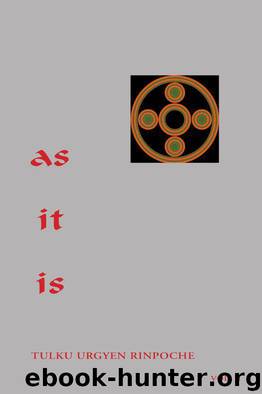As It Is, Volume 2 by Urgyen Tulku Rinpoche

Author:Urgyen, Tulku, Rinpoche [Urgyen, Tulku, Rinpoche]
Language: eng
Format: azw3
ISBN: 9789627341710
Publisher: Random House Inc Clients
Published: 2011-12-06T02:00:00+00:00
And:
Grant your blessings so that my meditation is free from conception.
“Nothing whatever” means that mind essence is no concrete thing. The very moment you recognize, it is like a totally pure space. The nature of mind is not made out of any thought or concept whatsoever; it is utterly free of any of that. That is obvious, and it is seen in actuality the very moment you recognize. You see that there is not even as much as a speck of dust of any concept in the essence itself. The song continues, “But everything arises,” meaning that all experience takes place because of the quality of cognizance, which is indivisible from the empty essence. Our natural ability to perceive is not blocked in any way whatsoever, it is unobstructed. The essence is not confined to being either empty or some material ‘thing’ that experiences. There is no split or barrier between being empty and being cognizant. The image often used is that of a bright mirror. The mirror is not obstructed in any way, yet at the same time it has a brightness, a natural capacity to reflect. That is the image for indivisible empty cognizance. It is unimpeded. The empty aspect is dharmakaya. The cognizant aspect is sambhogakaya, and the indivisibility of these two is nirmanakaya. The three kayas are present as the nature of every sentient being’s mind. When the master points this out and it is recognized, it is svabhavikakaya. This fact, that the mind is unconfined empty cognizance, is realized the moment we recognize, the moment we simply see it.
In the moment of recognizing that, simply allow it to be, however it is. We don’t have to pre-meditate the nature of mind. Don’t ever think, “All right, I’ll recognize, but it has to look a certain way, and if it doesn’t live up to that, then I should correct it a little, improve it.” Or “Hmmm, maybe this is not exactly the nature of mind. The nature of mind must be more special than this.” Or, “Is this empty now?” Or “Now it is cognizant! Or is it?” Or, “This is the unity, I believe … actually, maybe not.” That kind of meditation is not necessary at all. The guidance texts mention over and over that the moment you recognize, you must abandon all preconceptions. Mind essence does not require our improvement.
Can we make up mind essence? Is it an entity that can be imagined and then kept in mind? Try to imagine that which is utterly empty; it is impossible, right? Likewise, can you imagine the cognizance? One cannot really do that. If your meditation practice is merely an exercise in imagining mind essence, doesn’t that become one’s invention? Isn’t it repeatedly said that mind essence is not necessarily one’s idea of how it actually is? “Uncontrived ordinary mind is the highway of all the victorious ones.” That is the essential practice itself.
Do not be like a bird that has been caught in a snare. You know how kids put out a trap, and when the bird comes, they pull and it gets caught in it.
Download
This site does not store any files on its server. We only index and link to content provided by other sites. Please contact the content providers to delete copyright contents if any and email us, we'll remove relevant links or contents immediately.
The Way of Zen by Alan W. Watts(6292)
Ego Is the Enemy by Ryan Holiday(4964)
The Art of Happiness by The Dalai Lama(3851)
The Book of Joy by Dalai Lama(3709)
Why Buddhism is True by Robert Wright(3291)
Spark Joy by Marie Kondo(3091)
Shift into Freedom by Loch Kelly(3032)
Happiness by Matthieu Ricard(2890)
A Monk's Guide to a Clean House and Mind by Shoukei Matsumoto(2787)
The Lost Art of Good Conversation by Sakyong Mipham(2444)
The Meaning of the Library by unknow(2394)
The Third Eye by T. Lobsang Rampa(2174)
The Unfettered Mind: Writings from a Zen Master to a Master Swordsman by Takuan Soho(2160)
Red Shambhala by Andrei Znamenski(2074)
Anthology by T J(2049)
The Diamond Cutter by Geshe Michael Roach(1957)
Thoughts Without A Thinker: Psychotherapy from a Buddhist Perspective by Epstein Mark(1901)
Advice Not Given by Mark Epstein(1767)
Twilight of Idols and Anti-Christ by Friedrich Nietzsche(1764)
